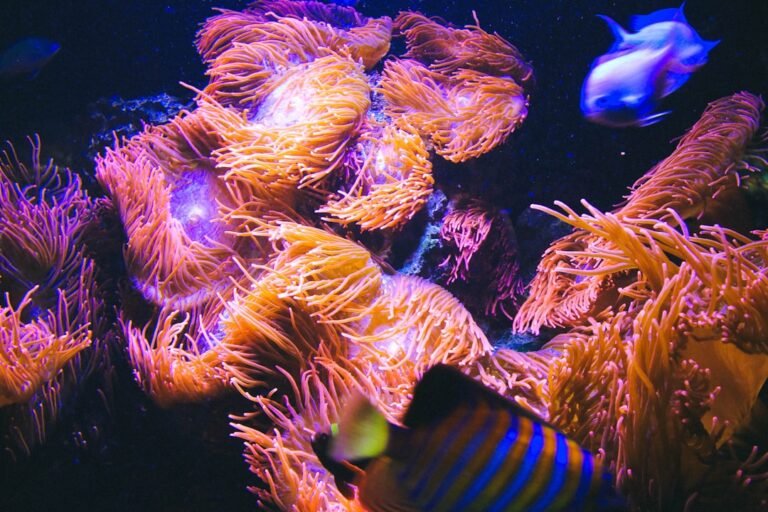The ocean covers more than 70% of the Earth’s surface, making it the largest habitat on the planet. Its vastness and depth have captivated human imagination for centuries, and it continues to hold many mysteries waiting to be unraveled. The ocean is home to a diverse array of ecosystems, from the sunlit surface waters to the dark, cold depths of the abyssal zone. Its sheer size and complexity make it a challenging environment to study and explore, but the rewards are immeasurable. The ocean plays a crucial role in regulating the Earth’s climate, providing food and livelihoods for millions of people, and harboring an incredible diversity of life. As we delve into the depths of the ocean, we discover a world that is both beautiful and enigmatic, filled with wonders that continue to inspire awe and wonder.
The ocean is a dynamic and ever-changing environment, shaped by powerful forces such as currents, tides, and weather patterns. Its waters are teeming with life, from the tiniest plankton to the largest whales. The ocean also holds a wealth of resources, including minerals, oil, and gas, which have been exploited for centuries. However, our understanding of the ocean is still limited, and there is much that remains unknown about this vast and mysterious realm. As we continue to explore and study the ocean, we gain valuable insights into its complex ecosystems and the interconnectedness of all life on Earth. The ocean is not only a source of fascination and wonder but also a vital component of the planet’s ecological balance, making it essential for us to protect and preserve its fragile ecosystems for future generations.
Key Takeaways
- The ocean is a mysterious and vast planet with many unexplored depths.
- Marine life encompasses a wide range of organisms, from tiny microorganisms to massive whales.
- The ocean floor holds hidden treasures and ancient secrets waiting to be uncovered.
- Human activity has had a significant impact on the ocean, including pollution, overfishing, and climate change.
- Technologies such as submersibles, ROVs, and satellite imaging have revolutionized ocean exploration.
The Diversity of Marine Life: From Microscopic Organisms to Giant Whales
The ocean is home to an astonishing variety of life forms, ranging from tiny microbes to massive whales. Its diverse ecosystems support an incredible array of species, each adapted to its own unique niche within the marine environment. From colorful coral reefs teeming with fish to the dark depths of the abyss where strange and otherworldly creatures dwell, the ocean is a treasure trove of biodiversity. Microscopic organisms such as phytoplankton form the base of the marine food web, producing oxygen and serving as a vital source of sustenance for countless other marine organisms. In contrast, large marine mammals like whales and dolphins captivate our imagination with their intelligence and grace, roaming the open ocean in search of food and mates. The sheer diversity of marine life is a testament to the adaptability and resilience of living organisms in the face of extreme environmental conditions.
The ocean’s ecosystems are finely balanced, with each species playing a crucial role in maintaining the health and stability of the marine environment. From tiny shrimp to majestic sharks, every creature has its place in the intricate web of life that spans the world’s oceans. Coral reefs, often referred to as the “rainforests of the sea,” are particularly rich in biodiversity, supporting a multitude of fish, invertebrates, and other marine organisms. These vibrant and colorful ecosystems are not only visually stunning but also provide essential services such as coastal protection and fish nurseries. As we continue to explore the ocean’s depths, we uncover new species and behaviors that challenge our understanding of life on Earth. The diversity of marine life is a source of wonder and inspiration, reminding us of the importance of preserving these precious ecosystems for future generations.
Exploring the Ocean Floor: Uncovering Hidden Treasures and Ancient Secrets
The ocean floor is a vast and largely unexplored landscape that holds many secrets waiting to be discovered. From towering underwater mountains to deep-sea trenches, the topography of the ocean floor is as diverse and fascinating as any on land. Volcanic activity, tectonic forces, and erosion have shaped the underwater landscape over millions of years, creating a rich tapestry of geological features. The ocean floor also holds valuable mineral deposits such as manganese nodules and hydrothermal vents that support unique ecosystems adapted to extreme conditions. As we explore these hidden realms, we gain insights into Earth’s geological history and the processes that continue to shape our planet.
The ocean floor is not only a source of geological wonders but also a repository of ancient artifacts and archaeological sites. Shipwrecks, lost cities, and sunken treasures lie scattered across the seabed, offering tantalizing glimpses into human history and culture. These underwater archaeological sites provide valuable clues about past civilizations and maritime trade routes, shedding light on our shared heritage as seafaring beings. The exploration of the ocean floor is a journey into both the distant past and the future, as we seek to understand the forces that have shaped our planet and uncover the hidden treasures that lie beneath the waves.
The Impact of Human Activity: Pollution, Overfishing, and Climate Change
| Issue | Impact | Consequences |
|---|---|---|
| Pollution | Degrades water and air quality | Threatens human health and disrupts ecosystems |
| Overfishing | Reduces fish populations | Disrupts marine food chains and livelihoods of fishing communities |
| Climate Change | Alters global temperatures and weather patterns | Leads to sea level rise, extreme weather events, and habitat loss |
Human activities have had a profound impact on the health and stability of marine ecosystems around the world. Pollution from industrial runoff, plastic waste, and oil spills has contaminated coastal waters and harmed marine life. Overfishing has depleted fish stocks and disrupted food webs, leading to declines in important commercial species such as tuna and cod. Climate change has caused sea temperatures to rise, leading to coral bleaching and habitat loss for many marine species. These human-induced pressures threaten the delicate balance of marine ecosystems and have far-reaching consequences for both marine life and human communities that depend on the ocean for their livelihoods.
The effects of human activity on the ocean are not limited to local or regional scales but have global implications for the health of our planet. The interconnected nature of marine ecosystems means that changes in one part of the ocean can have cascading effects throughout the entire system. For example, overfishing in one area can lead to population declines in predator species elsewhere, disrupting food webs and altering ecosystem dynamics. Similarly, pollution from land-based sources can be carried by ocean currents across vast distances, affecting marine life far from its point of origin. As we come to realize the extent of our impact on the ocean, it becomes increasingly urgent to take action to mitigate these threats and protect the health of marine ecosystems for future generations.
Technologies for Ocean Exploration: Submersibles, ROVs, and Satellite Imaging
The exploration of the ocean’s depths has been made possible by advances in technology that allow us to study and observe marine environments in ways that were once unimaginable. Submersibles such as manned submarines and remotely operated vehicles (ROVs) enable scientists to descend into the abyssal depths and study deep-sea ecosystems firsthand. These sophisticated machines are equipped with cameras, sensors, and sampling tools that allow researchers to collect data and samples from even the most remote and inhospitable parts of the ocean floor. Satellite imaging technology provides a bird’s-eye view of the ocean’s surface, allowing scientists to monitor changes in sea ice extent, sea surface temperatures, and ocean currents on a global scale.
The use of advanced technologies for ocean exploration has revolutionized our understanding of marine ecosystems and has led to many groundbreaking discoveries. For example, ROVs have captured stunning footage of deep-sea creatures such as giant squid and elusive jellyfish that were previously known only from anecdotal reports or specimens washed ashore. Satellite imaging has enabled scientists to track the movements of marine animals such as whales and sea turtles across vast distances, providing valuable insights into their behavior and migration patterns. As technology continues to evolve, our ability to explore and study the ocean will only improve, opening up new frontiers for discovery and innovation.
Conservation Efforts: Protecting Marine Ecosystems and Endangered Species

Conservation efforts play a crucial role in safeguarding the health and resilience of marine ecosystems around the world. Marine protected areas (MPAs) are established to preserve critical habitats such as coral reefs, seagrass meadows, and breeding grounds for marine mammals. These designated areas provide refuge for vulnerable species and help to maintain biodiversity within the larger marine environment. Conservation organizations work tirelessly to raise awareness about threats facing marine ecosystems such as pollution, overfishing, and habitat destruction, advocating for sustainable management practices that minimize human impact on the ocean.
Endangered species such as sea turtles, whales, and sharks are also the focus of conservation efforts aimed at protecting their populations from further decline. Measures such as fishing quotas, bycatch reduction strategies, and habitat restoration projects are implemented to mitigate human-induced threats to these iconic marine animals. Public education campaigns play a vital role in engaging communities in conservation efforts by fostering a sense of stewardship for the ocean and its inhabitants. By working together to protect marine ecosystems and endangered species, we can ensure that future generations will continue to benefit from all that the ocean has to offer.
The Future of Ocean Exploration: New Discoveries and Challenges Ahead
The future of ocean exploration holds great promise for new discoveries that will expand our knowledge of marine ecosystems and their inhabitants. Advances in technology will continue to drive innovation in underwater robotics, sensor technology, and data analysis methods that will enable us to explore previously inaccessible parts of the ocean with greater precision and detail. New species will be discovered, ancient mysteries will be unraveled, and our understanding of how marine ecosystems function will be enriched by ongoing research efforts.
However, along with these exciting opportunities come significant challenges that must be addressed in order to ensure a sustainable future for our oceans. Climate change poses a major threat to marine ecosystems through rising sea temperatures, ocean acidification, and extreme weather events that can disrupt fragile habitats and alter species distributions. Overfishing continues to deplete fish stocks around the world, leading to declines in important commercial species and threatening food security for coastal communities. Pollution from plastic waste, industrial runoff, and oil spills continues to contaminate coastal waters and harm marine life.
As we look ahead to the future of ocean exploration, it is clear that concerted efforts are needed to address these pressing challenges through international collaboration, scientific research, and public engagement. By working together to protect marine ecosystems from human-induced threats and mitigate climate change impacts on the ocean, we can ensure that future generations will continue to benefit from all that this wondrous realm has to offer. The mysteries of the deep await us, ready to reveal their secrets as we embark on a journey into the unknown depths of our planet’s greatest frontier—the ocean.
Discover the wonders of the ocean planet with our latest article, which delves into the fascinating world beneath the waves. From vibrant coral reefs to mysterious deep-sea creatures, there’s so much to explore and learn about. And speaking of exploration, the changing landscape of our world is also reflected in the evolving realm of cricket, as highlighted in a recent article from Just Tidings. Whether you’re a fan of marine life or cricket, there’s always something new and exciting to discover!




















+ There are no comments
Add yours